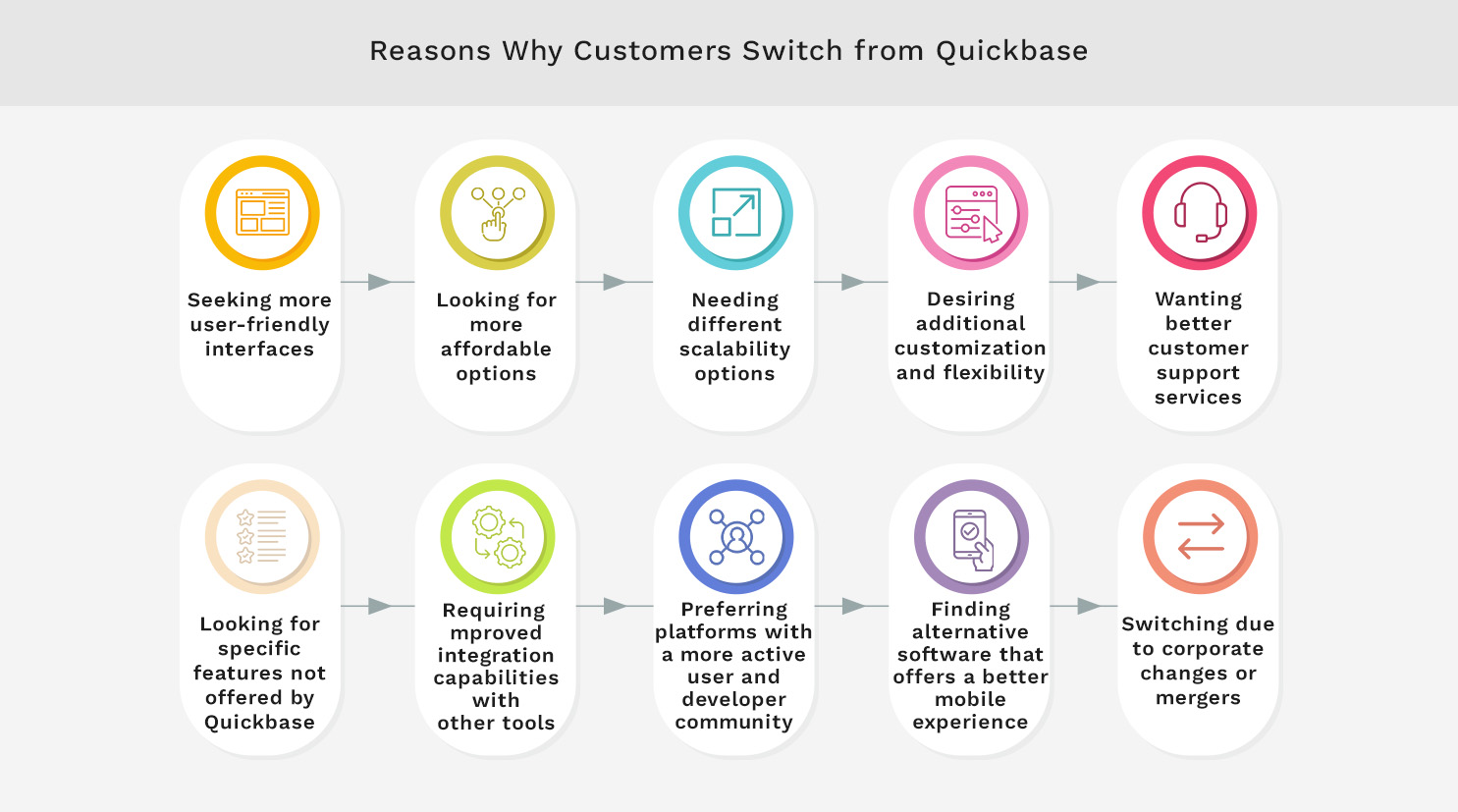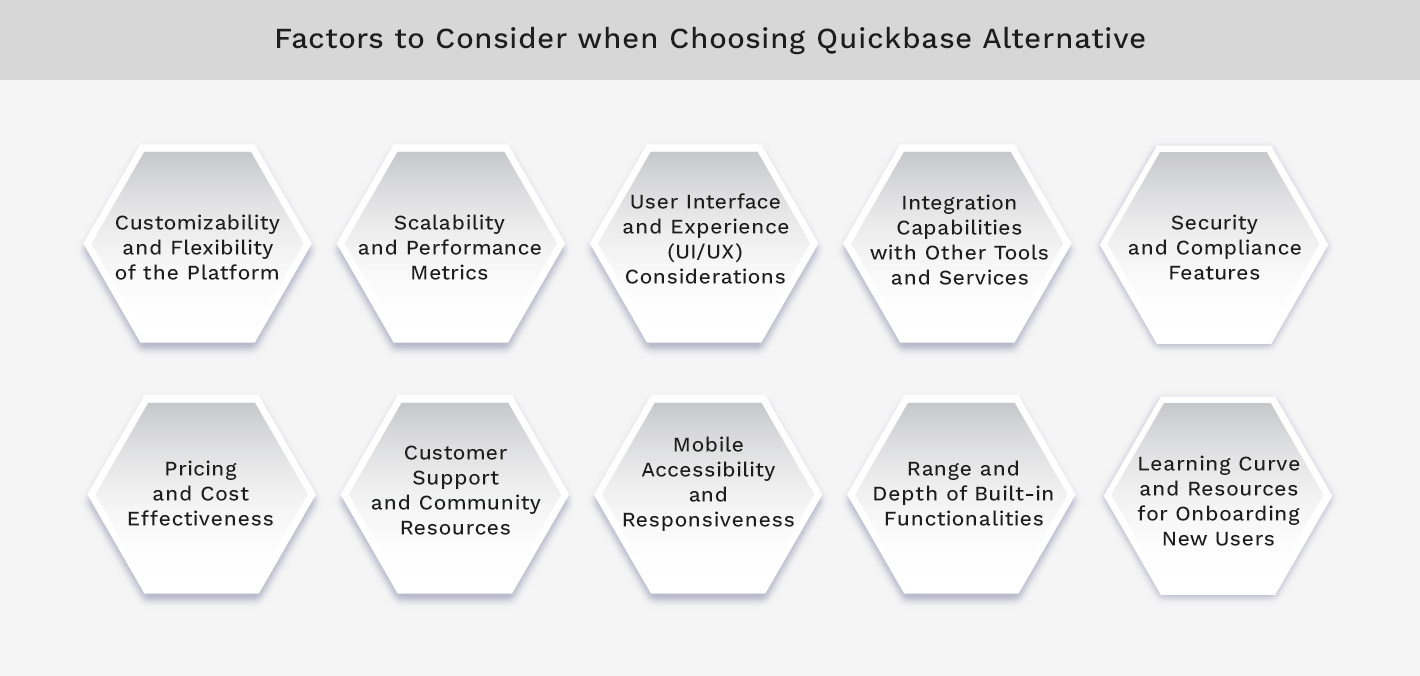Choosing the right no-code app builder is essential for businesses looking to streamline their processes and increase efficiency. Quickbase is a popular choice, but it's not the only option. In fact, research shows that 84% of businesses now use low-code or no-code tools to address the shortage of developers and fill the technical gap. This is because these platforms help reduce app development time by 90% and consume 70% fewer resources than conventional app-building platforms.
This article will explore the top 11 Quickbase alternatives, helping you find the perfect tool for your needs.
We'll buid your first application for you. At no extra cost.
Let us build your first business application for free. Go from an idea to an application in under 2 weeks.

What Is Quickbase?

Quickbase is a no-code platform that allows businesses to create custom applications without needing advanced programming skills. It helps teams automate workflows, manage projects, and streamline operations. With Quickbase, users can quickly build and modify apps to fit their specific needs, making it a versatile tool for improving productivity and efficiency.
Reasons Why Customers Switch from Quickbase
Here are some reasons why customers switch from Quickbase. Understanding these can help you decide if it’s the right fit for your needs.
Seeking more user-friendly interfaces
For those accustomed to the smooth glide of user-friendly interfaces, sometimes Quickbase's arrangement might not be the best choice. If you find yourself seeking interfaces that resonate more intuitively with your workflows, you're not alone.
Many businesses switch gears to platforms that offer more engaging and easier-to-navigate UIs, reducing the learning curve and increasing productivity. They're after tools that fine-tune every interaction to create a seamless user experience.
Looking for more affordable options
Quickbase, with its enterprise-grade features, often comes with a hefty price tag. Finding a solution that aligns with your budget without sacrificing quality or functionality is crucial. That's why many search for less expensive alternatives to Quickbase, hoping to discover solutions that don't break the bank but still offer a rich set of features.
Needing different scalability options
Some might find Quickbase's scalability works well initially, but as their user base grows or data storage needs increase, it can become limiting. This is where different scaling options offered by alternatives can be appealing. They allow you to expand without worrying about unexpected limits or high costs.
Desiring additional customization and flexibility
Users often leave Quickbase looking for more creative control over their applications. They want to be able to choose UI designs, elaborately scripted functionalities, or deep integration capabilities. They seek platforms that fit their vision, not the other way around.
Wanting better customer support services
Some Quickbase users leave looking for customer support services that aren't just present but also proactive, responsive, and genuinely helpful. They value prompt and comprehensive support to resolve issues quickly, ensuring that the technical side of their business operates without a hitch.
Looking for specific features not offered by Quickbase
Some users transition away from Quickbase because they're searching for platforms that offer particular features that Quickbase might not provide. The right feature can unlock your app's full potential, be it advanced AI capabilities, specialized reporting tools, or industry-specific widgets.
Requiring improved integration capabilities with other tools
Some businesses leave Quickbase to look for a no-code platform with more robust integration capabilities. They require a tool that can seamlessly bridge their existing software with new applications, optimizing workflows and data synchronization. Improved integration means less manual labor and a cohesive, automated environment.
Preferring platforms with a more active user and developer community
An active user and developer community provides support, inspiration, and collective intelligence. Some Quickbase users might feel this is lacking, driving them to look for alternatives with forums, user groups, and community-driven events. Such environments can greatly aid in troubleshooting, networking, and harvesting fresh ideas.
Finding alternative software that offers a better mobile experience
Users who want a smooth transition between desktop and mobile screens might find Quickbase's mobile experience lacking. That’s why they look for alternative software that can provide a seamless, responsive, and engaging mobile experience. A superior mobile experience is important for users expecting to manage their workflows from their mobile devices.
Switching due to corporate changes or mergers
Users may switch to an alternative no-code platform as a result of corporate changes like mergers and acquisitions. They seek solutions that better align with new management directives, operational processes, or company culture.

Top 11 Quickbase Alternatives
If you're looking for alternatives to Quickbase, here are the top 11 options to consider. Each offers unique features to help you build no-code apps easily and efficiently.
1. Quickbase vs. Kohezion

Kohezion prides itself on offering a highly personalized approach to app development. It lets you build applications that feel tailored to your specific business needs.
Top 5 features:
- Drag-and-drop interface that simplifies app creation.
- Robust reporting and data analysis tools.
- Flexible dashboard configurations for personalized data visualization.
- Comprehensive training and support to help navigate the platform.
- Advanced security features that protect your data integrity.
Five benefits:
- No steep learning curve, making it accessible for non-technical users.
- A cost-effective alternative with a generous free tier for smaller teams.
- Can handle complex data relationships easily.
- Offers a cloud-based solution that enables remote collaboration.
- Regular updates with new features and improvements based on user feedback.
Two cons:
- May not scale as seamlessly as Quickbase for very large enterprise needs.
- Integration options could be more limited in comparison.
Best for: Users who prefer a straightforward, no-frills approach to app building with a strong emphasis on user support and a community feel.
2. Quickbase vs. Airtable

Airtable is a strong contender for those who lean towards visually appealing and intuitively designed interfaces. With its spreadsheet-like setup, Airtable offers familiarity infused with the power of a database.
Top 5 features:
- A user-friendly interface that mimics the look and feel of a spreadsheet.
- Rich field types including attachments, long text notes, checkboxes, and more.
- Flexible views such as Kanban, Grid, Calendar, and Gallery.
- Powerful filtering, sorting, and grouping to manage and visualize data.
- Block extensions that add extra functionality like Gantt charts or pivot tables.
Five benefits:
- Quick setup time accelerates onboarding and productivity.
- Competitive pricing plans that cater to different organizational sizes.
- High levels of customization allow for diverse use cases.
- Strong collaborative features that enable team synergy.
- Robust template gallery for a quick start on numerous project types.
Two cons:
- When handling large databases, Airtable might experience performance issues.
- More complex integrations may require third-party tools.
Best for: Users who enjoy the familiarity of spreadsheets but need additional power for task management, project tracking, and CRM activities, among others.
3. Quickbase vs. Zoho Creator

Zoho Creator is a tech-savvy alternative to Quickbase. It is known for its robust support for external data, particularly with SaaS platforms. This makes it a hit for those who prioritize external integrations and a seamless flow of information across their business ecosystems.
Top 5 features:
- Multiple integration options with CRM, workload management, and marketing platforms.
- Granular governance controls to fine-tune user access and data interaction.
- JavaScript support for improved front-end customization.
- An intuitive drag-and-drop interface for the construction of custom applications.
- Automation capabilities that streamline complex business processes.
Five benefits:
- Connects to different external sources to simplify data management.
- customizable roles and permissions increase security.
- Saves time and resources with easy-to-implement workflow automation.
- The ability to extend app functionalities with coding encourages innovation.
- Offers comprehensive support and documentation to aid development.
Two cons:
- Limited in-built templates may restrict out-of-the-box usage for those seeking quick deployment.
- Can be overwhelming for absolute beginners due to the advanced options available.
Best for: Companies looking to improve their application's interconnectivity with existing SaaS solutions. It’s also a great choice for users comfortable with front-end scripting for a deeper level of customization.
4. Quickbase vs. Caspio

Caspio is a great option for those disappointed with Quickbase's user-based pricing and scalability concerns. Caspio offers unlimited users, which is a blessing for growing businesses that worry about escalating costs linked to user licenses.
Top 5 features:
- Microsoft SQL Server backing ensures industry-standard database management and security.
- Amazon Web Services infrastructure promises high reliability and global distribution.
- A flexible deployment model allows for varied publishing options, including on websites and SharePoint.
- Advanced data import/export functionalities support bulk processes and multiple file types.
- Editable grids, table relationships, and referential integrity streamline application development.
Five benefits:
- Cost predictability with scalable options that avoid per-user charges.
- Flexibility to embed apps across different platforms, improving user outreach.
- Reliability backed by top-tier cloud infrastructure.
- Superior data handling capabilities that cater to complex organizational needs.
- User-friendly app development process guiding users to a finished product efficiently.
Two cons:
- The interface may require a steeper learning curve for some, especially those new to no-code solutions.
- Advanced features might necessitate more technical prowess, which could be daunting for non-technical users.
Best for users who: Organizations expecting significant user growth without wanting to increase expenditure.
5. Quickbase vs. OutSystems

OutSystems caters to enterprise-level development needs. It has powerful tools to update old systems and is ideal for creating modern, responsive web applications that support digital transformation.
Top 5 features:
- Robust platform to create complex systems while adhering to high-performance demands.
- Cross-platform development capabilities ensuring responsiveness and compatibility.
- Extensive integration options with existing enterprise systems and databases.
- A visual development environment that reduces the barrier for producing full-stack applications.
- A strong community and partner ecosystem provide an array of resources.
Five benefits:
- Accelerated development cycle due to its visual, model-driven environment.
- High scalability that keeps pace with business growth and evolution.
- Responsive design out of the box, improving user experience on any device.
- Advanced security features are baked into the platform for enterprise-grade compliance.
- Ability to handle complex data models and business logic with relative ease.
Two cons:
- The comprehensive nature of the platform could be overwhelming for smaller teams or less complex project requirements.
- Deployment and ongoing maintenance may require more IT involvement compared to simpler no-code options.
Best for: Large organizations looking to replace old systems without lengthy downtime. It is also perfect for teams that want to create intricate, scalable applications that perform seamlessly across different devices.
6. Quickbase vs. AppSheet

AppSheet has a spreadsheet-centric approach that enables Google Sheets-savvy users to build powerful, data-driven applications quickly.
Top 5 features:
- Direct integration with Google Sheets and other data sources for real-time updates.
- Intuitive design functionality keeping apps user-friendly and on-brand.
- Robust conditional formatting rules to highlight key data and insights.
- Automated workflows and reporting that sync with changes in the connected data.
- Customizable access controls to manage team permissions and data security.
Five benefits:
- Effortless app creation aligns perfectly with existing spreadsheet management systems.
- High compatibility with mobile devices, ensuring a strong on-the-go performance.
- Accessible automation and data manipulation simplify complex processes.
- Encourages collaboration and productivity with shared data at its core.
- Quick deployment of tools to streamline operations and mitigate manual data entry.
Two cons:
- While user-friendly, it might lack the depth required for constructing highly advanced applications.
- Its close ties to spreadsheets could limit creative design freedom compared to more open-ended platforms.
Best for: Companies heavily invested in Google Workspace looking to capitalize on their existing spreadsheets. It also benefits users seeking a straightforward transition from spreadsheet data management to a full-fledged app.
7. Quickbase vs. Knack

Knack has features to enrich and organize complex datasets. It appeals to users who want to streamline their operations down to the fine granularity of their data.
Top 5 features:
- Customizable data fields allow tailored data types, like emails or names.
- Data linking capabilities that associate and unify related records logically.
- Powerful search and query functionality with advanced filters for fine-tuned record retrieval.
- Inline and bulk editing options to manage data efficiently within the platform.
- Remote accessibility across devices with strong data protection through user permissions.
Five benefits:
- Offers a level of data specificity which brings precision to apps.
- An intuitive design that requires minimal technical knowledge to navigate.
- Supports a wide range of use cases from CRM to project management.
- No-code formula options extend data manipulation beyond mere data entry.
- Promotes data integrity and security with fine-grained access controls.
Two cons:
- Some users may find the platform’s design capabilities to be less visually dynamic than others.
- The simplistic approach to app design might not meet the needs of users looking for more sophisticated functionalities.
Best for: Data enthusiasts who want to mold, link, and leverage their information for optimized performance. It’s also a great choice for teams that need a straightforward way to structure and analyze different data types.
8. Quickbase vs. Ninox

Ninox is great for teams that use Apple ecosystems and those who want a more visual approach to database construction. It allows users to create custom, interconnected apps with visually intuitive interfaces and seamless syncing across all Apple devices.
Top 5 features:
- Native integration with Mac, iPad, and iPhone ensures seamless optimization, providing a smooth and optimized user experience.
- Drag-and-drop interface that simplifies the creation of forms, fields, and views.
- A built-in scripting language that offers extra layers of customization without full coding.
- Strong collaboration capabilities backed by simultaneous syncing on multiple devices.
- Template library to jumpstart application development across different categories.
Five benefits:
- Improves productivity with cross-device compatibility and synchronization.
- Allows non-technical users to create complex databases effortlessly.
- Promotes team collaboration with user-friendly sharing and permissions settings.
- Assists in maintaining consistency and accuracy with real-time updates.
- Thanks to its adaptable feature set, it grants the flexibility to create both simple and sophisticated apps.
Two cons:
- Users outside of Apple’s ecosystem might not experience the platform fully.
- Those seeking more advanced customizations and scripting might require more time to learn.
Best for: Apple users who desire an app creator that plays nice across all their devices and businesses that value a visually driven and straightforward database creation process.
9. Quickbase vs. Bubble

Bubble offers robust tools for building fully customizable web applications from scratch.
Top 5 features:
- A flexible, drag-and-drop editor catering to comprehensive design customization.
- Rich database management capabilities without the need for SQL or other query languages.
- Dynamic content and conditional logic presentation, enabling interactive user experiences.
- API connectors provide integration with different services.
- Extensive community-built templates and plugins that expand the platform's capabilities.
Five benefits:
- Offers complete creative freedom for app builders with a vision detailed down to the last pixel.
- Helps create complex, data-intensive applications that can scale with user demands.
- Supports a variety of app types, from marketplaces to SaaS products.
- Fosters a robust user community that contributes to a vast repository of resources and support.
- Streamlines design and backend processes for a cost-effective development pathway.
Two cons:
- The learning curve can be steep with its wide array of features and customization.
- While highly customizable, some integrations may require a workaround or third-party services.
Best for: Budding web developers and entrepreneurs who aim to create feature-rich web apps without coding. It is also a good choice for users who value deep customization and control over every aspect of their application's design and functionality.
10. Quickbase vs. Mendix

Mendix stands out for its agility and rapid application development. It's a great choice for enterprises that need to design, iterate, and deploy apps at lightning speed, supported by robust cloud-native architecture.
Top 5 features:
- High-productivity platform that enables both no-code and low-code development.
- Agile project management tools are baked into the development environment.
- Multi-channel app development capabilities, efficiently catering to mobile and web.
- Extensive suite of out-of-the-box connectors for seamless integration with other systems.
- Sophisticated cloud-native architecture, ensuring scalability and resilience.
Five benefits:
- Accelerates the application development lifecycle from concept to deployment.
- The integrated development approach improves collaboration across business and IT teams.
- Facilitates the creation of responsive and intuitive user experiences on different devices.
- Allows for easy integration with legacy systems, safeguarding against disruption.
- Supports a grow-as-you-go approach, ideal for businesses with evolving needs.
Two cons:
- While offering a diversity of development paths, it may present an intimidating learning curve for purely no-code users.
- The platform's robustness and enterprise focus may come with a price tag that's not as friendly to smaller businesses.
Best for: Enterprises that need rapid application development and deployment cycles. It’s also a good option for teams that require a blend of no-code and low-code to accommodate a wide range of technical expertise.
11. Quickbase vs. Glide

Glide has an impressive pitch for simplicity and speed. It’s for users who want to turn spreadsheets into beautiful, functional apps without getting into the complexities of code or database design.
Top 5 features:
- Direct integration with Google Sheets for real-time data sync.
- Intuitive drag-and-drop builder that requires zero coding skills.
- A rich library of templates catering to different business needs and verticals.
- Live editing feature allowing users to see changes in real-time.
- The ability to share apps instantly, supporting quick iteration and feedback.
Five benefits:
- Uses familiar spreadsheet-based data to reduce app development time.
- Enables instant prototyping and testing to accelerate the design process.
- Fosters user engagement with visually appealing and easy-to-navigate mobile interfaces.
- Offers a cost-effective solution for small businesses and solo entrepreneurs.
- Encourages continuous improvement with simple app-sharing options and instant updates.
Two cons:
- The platform might not scale as robustly as Quickbase for more complex or larger enterprise needs.
- Limitations in customization and integration when compared to more comprehensive no-code platforms.
Best for: Individuals and teams who wish to leverage existing spreadsheet data to construct apps quickly, as well as non-technical users targeting the creation of straightforward, user-friendly mobile applications.
Factors to Consider when Choosing Quickbase Alternative
When looking for an alternative to Quickbase, several factors must be considered to ensure you choose the right fit for your needs. Here are some essential points to keep in mind.
Customizability and Flexibility of the Platform
Check how much you can tailor the platform to fit your precise workflow, aesthetic, and functionality requirements. The ideal candidate should be capable of reflecting your brand and scaling alongside your business without costly or time-intensive redevelopment.
Think of customizability in terms of UI customization, data fields, app logic, and integration possibilities. Flexibility, on the other hand, should be evident in the platform's ability to accommodate different project sizes, complexities, and changes in business strategies.
Scalability and Performance Metrics
Look for a platform that fits today's needs and seamlessly grows with your future ambitions. Check the performance metrics—look for user limits, data storage capacity, and the speed at which the platform can process complex transactions under increased loads. Consider how fast the platform allows you to add users and data, how it manages large traffic spikes, and its uptime guarantee.
User Interface and Experience (UI/UX) Considerations
Check how intuitively you can navigate the app builder, and how pleasant and efficient the resulting applications are. Analyze the UI elements, the design options, mobile responsiveness, and user engagement features. Look for a balance between aesthetic appeal and functional clarity.
Integration Capabilities with Other Tools and Services
The ideal platform should integrate seamlessly with the tools and services your business already uses. Check how each platform connects with APIs, whether it has built-in integrations or supports common data connectors like Zapier. The ability to integrate can turn an isolated application into a central hub for your business.
Security and Compliance Features
A Quickbase alternative's security and compliance unveils the platform's commitment to protecting your data. Look for security certifications, data encryption standards, permission controls, and compliance with GDPR, HIPAA, or SOC2 regulations.
Pricing and Cost Effectiveness
Understand the total cost of ownership of the Quickbase alternative you’re considering. This includes subscription fees, any additional costs for extra features, scalability impacts on price, and the return on investment (ROI) that the platform promises.
Look for transparent pricing models that align with your user base and usage intensity. The cheapest option isn’t always the most cost-effective. Weigh the benefits each platform offers against their cost to gauge the real value for your business.
Customer Support and Community Resources
Customer support can vary widely among Quickbase alternatives, with some platforms offering 24/7 assistance, dedicated account managers, or comprehensive knowledge bases for self-help aficionados.
A vibrant community, on the other hand, can offer shared experiences, user-created resources, and peer-to-peer support. Look for forums, user groups, and perhaps even local meetups where you can exchange tips and find reliable support.
Mobile Accessibility and Responsiveness
Look for platforms that offer a mobile-friendly view and mobile-optimized functionality. It is very important that users can easily achieve their tasks on tablets and smartphones. The platform's responsive nature—how it adapts to different device resolutions, loading speeds, and touch interactions—also speaks volumes about its viability in a mobile-first world.
Range and Depth of Built-in Functionalities
Analyze the functions a Quickbase alternative offers and how these capabilities are implemented. Can the platform accommodate complex data relationships? How sophisticated are its automation and analytics? These features contribute to a richer, more efficient app-building experience.
Learning Curve and Resources for Onboarding New Users
Evaluate each platform's learning curve. Some platforms are intuitive right from the get-go, while others offer extensive training materials, tutorials, and community courses to help flatten that learning incline. Check the onboarding resources provided, too. Tools like walkthrough guides, how-to videos, and live support can greatly streamline learning.

Build Your Apps with Kohezion No-Code App Builder
Kohezion is a no-code app builder that offers a combination of simplicity and power. It allows you to construct personalized applications that precisely fit your business narrative. With Kohezion, you can create, organize, and streamline data-driven apps without and coding skills.
Conclusion
Each no-code app builder is unique. While some offer simplicity and affordability, others focus on scalability and customization. Your goal is to identify which of these platforms fits your current needs but can also adapt to future business growth.
Keep in mind the features, pricing, support, and community that each option offers. Ready to start building your app? Contact Kohezion today and let’s talk about how we can help.
Start building with a free account
Frequently Asked Questions
Platforms like OutSystems or Mendix are a good match for large enterprises. These platforms offer robust integration capabilities, scalability, and full-stack development environments. Small businesses might favor alternatives like Airtable or Kohezion. These app builders offer affordability, ease of use, and a shorter learning curve to get started quickly and efficiently.
Many of the Quickbase alternatives provide integration capabilities with other systems. However, the ease of integration varies. Platforms like Airtable and Zoho Creator are known for their extensive integrations, making them a good choice for businesses that rely heavily on interoperability.
No-code app builders often include robust security features. These include data encryption, user authentication, role-based access control, and compliance with international standards like GDPR and SOC2. Zoho Creator and Mendix, for instance, are known for their stringent security measures that comply with different industry standards.
Yes, most no-code app builders offer trial versions or demo options, allowing you to test-drive their features before committing. Airtable, AppSheet, and Kohezion provide free trials. OutSystems and Mendix offer demo options to explore their platforms with guided insight.


